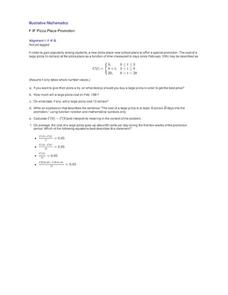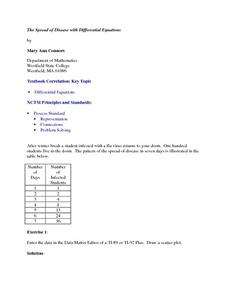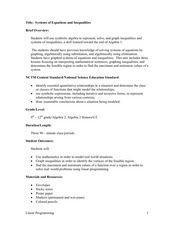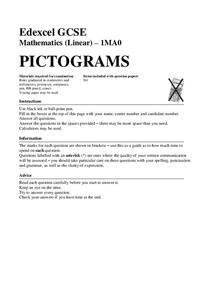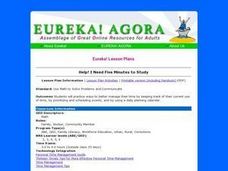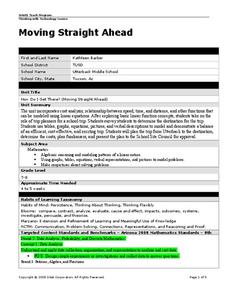Illustrative Mathematics
Pizza Place Promotion
The longer you wait to try the new pizza place, the more it's going to cost you! This real-world problem about how the cost of pizza varies with respect to time is a good example of how piecewise functions are used to describe...
Curated OER
Greater Than, Less Than, or Equal To
Elementary schoolers explore using the symbols for greater than, less than, and equal to in various equations. They discuss the different signs used in equations and what each sign represents. Learners practice using the various signs.
Curated OER
The Lawnmower Problem
In this algebra worksheet, students solve a word problem by rewriting it using math symbols. They calculate how fast the woman can mow the lawn given different scenarios. There is an answer key.
Curated OER
Intro to Mayan Numbers
Students investigate Mayan Numbers. In this algebra lesson, students compare our number system to the number system of the Mayans. They identify base 10 and base 20 numbers including zero in the Mayan symbols. They solve a Mayan problem.
Curated OER
Wacky Water World: Student Worksheet
For this math worksheet, students will work alone or in pairs to determine which theme park ticket package is a better deal. Students will use data provided in the worksheet and a graphing calculator to make the decision.
Curated OER
The Mayan Calendar
Students analyze the Mayan calendar and define its meaning. In this algebra lesson plan, students explain what the Mayan calendar means and how it works. They define the symbols and recreate a simplified version of the Mayan calendar.
Curated OER
The Spread of Disease with Differential Equations
Twelfth graders solve problems using differential equations. In this Calculus lesson, 12th graders analyze data regarding the spread of a flu virus. Students use the symbolic capacity of the TI-89 to develop a model and...
Curated OER
Digit Cells
In this algebra worksheet, students rewrite a word problem using algebraic symbols to find the digit in the first cell and tell how many zeros are in the entire digit number. There is an answer key.
Inside Mathematics
Coffee
There are many ways to correlate coffee to life, but in this case a worksheet looks at the price of two different sizes of coffee. It requires interpreting a graph with two unknown variables, in this case the price, and solving for...
Willow Tree
Order of Operations
It's the classic please excuse my dear aunt sally strategy to remembering the order of operations. Young mathematicians practice to develop an understanding of the order of operations. Examples and practice problems include...
EngageNY
Getting a Handle on New Transformations 1
In the first of a two-day lesson on transformations with matrix notation the class transforms the unit square using general transformations, then calculates the area of the transformed image. They discover it is the same as finding...
National Security Agency
Systems of Equations and Inequalities
High school classes can use manipulatives too! Offer hands-on, interactive lessons that venture away from the typical day in your algebra class. Young mathematicians will be involved in collaborative learning, visual...
Mathed Up!
Ordering Fractions, Decimals, and Percentages
Give scholars the opportunity to show what they know about ordering fractions, decimals, and percents with a five-page, eight-problem independent practice. With clear instructions and supportive advice, learners are bound for a...
National Security Agency
Equations and Expressions
Learners demonstrate their knowledge pictorially, concretely, and abstractly in this unit meant to last three hours over three days. Using hands-on activities, manipulatives, real-world applications, and problem...
Mathed Up!
Simple Perimeter, Area, and Volume
Young mathematicians find the area and perimeter of shaded shapes on a grid of unit squares. The sheets challenge class members to find the volume of various solid prisms. Each questions also includes the total value of suggest...
Mathed Up!
Pictograms
Young mathematicians read, interpret, and complete a variety of real-world pictograms. Each question includes a key and information to complete the graphs.
Mathed Up!
Mean, Median, Mode, and Range
Learners read a variety of word problems and find the mode, median, range, and mode from a given set of data. If calculators are not desirable, provide the class with notebook paper to work out the equations.
EngageNY
Transformations of the Quadratic Parent Function
Efficiently graph a quadratic function using transformations! Pupils graph quadratic equations by completing the square to determine the transformations. They locate the vertex and determine more points from a stretch or shrink and...
Penn Museum
Egypt
From pharaohs and pyramids to the mummification process, this packet is a fantastic resource for studying ancient Egypt! Worksheets not only review key terms and practices that are foundational to ancient Egyptian culture, such as...
Curated OER
Help! I Need Five Minutes
Students practice ways to better manage their time. They keep track of their current use of time. Students prioritize and schedule events and use a daily planning calendar to schedule their time.
Curated OER
Social Studies: Aztec Calendars and Culture
Sixth graders analyze the Aztec calendar and create their own examples of them. They determine the meaning of the symbols used in the calendars and record their ideas in journals. Students host a parent breakfast for them to observe...
Curated OER
The Adventures of Tom Sawyer: Themes (For the Most Part) Quiz
In this online interactive symbols quiz worksheet, learners respond to 5 multiple choice questions about themes from Twain's The Adventures of Tom Sawyer. Students may check their answers on this timed quiz.
Curated OER
Multiplication Lesson
Fourth graders use grid paper, M&M's, and vocabulary words, to correctly complete multiplication problems. For this multiplication lesson plan, 4th graders complete number sentences, use symbols, solve equations, and more.
Curated OER
Moving Straight Ahead
Pupils analyze the relationship between speed, time and distance. In this math instructional activity, students plan a school trip. Pupils determine the efficiency and cost effectiveness of a trip.
